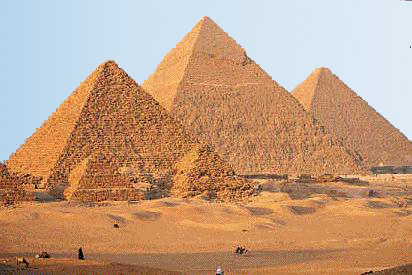
The stereotypical vision of the Egyptian Pyramids are large mountain like brown piles of stone uprooting from the desert having a rough contour. Though when first constructed around 2500 BC. The pyramids were paper white and as smooth as glass, toping the pyramid was a golden capstone that gleamed in the desert sun. It was an amazing spectacle. The pyramids somewhat stayed in this state until the Arab invasion of Egypt around AD 500. The Arab invaders stripped the pyramid of it's smooth limestone and built a huge section of Cairo. Many of the Mosques and Palaces of Cairo consist of the Ancient stones of the pyramids. Quite sad actually.
The pyramids of Giza were originally white.
When the pyramids were originally finished, they were plated in and outer layer of white “casing stones”. These casing stones were cut with astounding precision to give a smooth slope to the pyramids, unlike how they appear today with the outer stones more or less forming very large “steps”.
The original casing stones were made of highly polished Tura limestone, meant to reflect the sun’s rays, and were accurate within 1/100th of an inch. All total, they were around five feet long, five feet high, and six feet deep and weighed around 15 metric tons each once the face angle was cut, being around 40 metric tons before that for the full block.
So what happened to these casing stones? Many of them were cut loose and carried off to be used on various other structures, such as when Bahri Sultan An-Nasir Nasir-ad-Din al-Hasan used the polished stones from the Great Pyramid in building mosques in Cairo, some of which are still standing with these stones still intact.

No comments:
Post a Comment